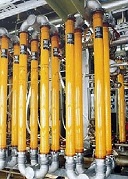
Hitherto, biocatalytic transformations rely on purified enzymes or whole cells. Whole cells are used because of their simple and cheap production on the one hand, and the relatively uncomplicated reusability on the other hand. Purified enzymes are applied in case of side or consecutive reactions catalyzed by endogenous enzymes of the host organism. However, in order to allow reusability of isolated enzymes they often have to be immobilized.
At the Institute of Biochemical Engineering a one-step expression and enzyme immobilization strategy in cellular envelopes of Escherichia coli was developed in a previous project as an alternative approach for the immobilization of enzymes. To achieve this, desired enzymes linked to membrane anchoring domains are immobilized in-situ in the cytoplasmic membrane in Escherichia coli cells after cytoplasmic expression. Subsequently, transmembrane pores are created by expression of a phage protein through which cytoplasm is released and can be separated by cross flow filtration. Thereby, the reduced costs for biocatalyst preparation of whole cells can be combined with decreased side reactions of purified enzyme systems. The activity of the created cellular envelopes is directly proportional to the number of immobilized enzymes.
Building on this, the project’s objective is the development of different strategies for maximizing the enzymatic activity per bacterial cellular envelope. This is realized by exemplarily applying a coupled two enzyme system for the production of chiral compounds. Following the induction and characterization of novel in-situ immobilization strategies bacterial cellular envelopes will be investigated regarding their potential for asymmetric syntheses. Finally, multiphase reaction setups with in-situ substrate supply and product removal and the process’ scalability will be examined.